My favourite April reads were the magical MG adventure Like A Charm by Elle McNicoll, and the historical fantasy The Vine Witch by Luanne G Smith. (I have the next two in this trilogy, and will hopefully get to them soon!) There were also faery tales, an intriguing spec fic novel, a new instalment in the brilliant Aussie STEM Stars series, and two wonderful kids books…
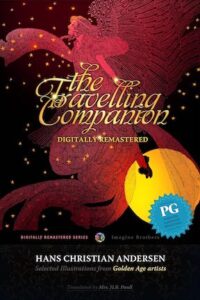 23 of 90 – The Travelling Companion and Other Grateful Dead tales
23 of 90 – The Travelling Companion and Other Grateful Dead tales
April’s topic for our Australian Fairy Tale Society discussions was the Grateful Dead tales, of which there are hundreds of variants. The most well-known is Hans Christian Andersen’s The Travelling Companion, but it’s not the best of them – you can read a huge selection of other ones here…
They are strange stories – like most faery tales! – but fascinating, and we had some awesome discussions about the poor man, the good deed, the cursed/evil/witchy/murdering princess, the helpful ghost, the evil sorcerer/wizard/devil, and what can and can’t be redeemed…
The “grateful dead” story is classified as Aarne-Thompson-Uther type 505. According to Stith Thompson, all of these tale types begin when the hero pays the creditors of a dead man, then later he meets a man in his travels who agrees to help him, as long as they divide in half whatever reward they may gain. All of the Rescued Princess, Monster’s Bride and Bride Won in a Tournament tales also fall into this category.
The most common story involves a traveller who encounters the corpse of someone who didn’t receive a proper burial, typically stemming from an unpaid debt. The traveller pays off the dead person’s debt or pays for burial, and is later rewarded or has his life saved by a person or animal who is actually the soul of the dead person. The grateful dead spirit may take many different physical forms, including that of a guardian angel, animal or fellow traveller.
* * *
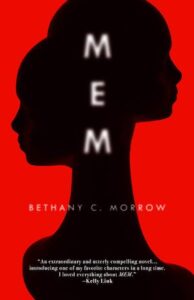 24 of 90 – Mem by Bethany C Morrow
24 of 90 – Mem by Bethany C Morrow
I adored Bethany C Morrow’s A Song Below Water, and her beautiful first novel Mem is gorgeous too. Set in Montreal in the early 20th century, she conjures a world of wonder and discovery, with a twist – to help his grieving wife, a scientist discovers how to extract painful and traumatic memories from a person’s mind, so they continue on as though nothing awful had happened. But rather than dumping them into the swirling mist of a pensieve, they reside in a Mem, a sort-of-clone person, who lives in a vault beneath the lab until they expire, living out that one awful moment over and over. Until one begins to have conversations unrelated to her Source, interact with the scientist, create her own memories, and finally live her own life in the city. How she learns – to be a friend, to function on her own, to meet her Source – is fascinating, until the sheer horror of her situation begins to crystalise, and the ethical questions emerge. What happens to a person if all their traumatic moments are erased? How do they live in the world? Who gets to decide who can and can’t have an extraction? And what are we without our memories? It’s a touching, heartbreaking and beautiful book about ownership and identity, history and ethics, and the power of the pain we endure to make us who we are.
[ETA 2024: It’s being turned into a movie! Awesome!]
* * *
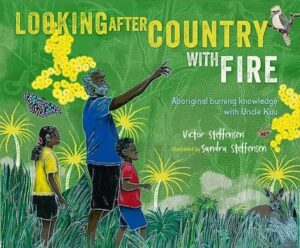 25 of 90 – Looking After Country with Fire by Victor Steffensen
25 of 90 – Looking After Country with Fire by Victor Steffensen
For many thousands of years, First Nations people have looked after Country by listening to the land and treating it with respect and care, which included specific fire burning practices to keep plants, animals and the land itself healthy. After the devastating Black Summer bushfires of 2019-2020, this traditional Indigenous knowledge is finally being sought out – and will hopefully be utilised. Tagalaka musician and film-maker Victor Steffensen, who grew up in Far North Queensland, is the co-founder of National Indigenous Fire Workshops. He wrote a best-selling book for adults called Fire Country, as well as this younger reader version, Looking After Country With Fire. Beautifully illustrated by his sister Sandra Steffensen, it’s a timely story about Aboriginal burning knowledge and caring for Country, and even includes a song he wrote, with a QR code to watch the video.
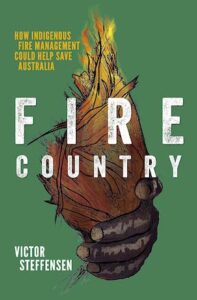 Here are two of my favourite answers from the interview I did with Victor for Australian Geographic Explorers mag…
Here are two of my favourite answers from the interview I did with Victor for Australian Geographic Explorers mag…
What inspired your new book Looking After Country With Fire?
After my first book Fire Country, I realised that trying to change old mindsets through bureaucracy is too slow and no fun, and we don’t have enough programs for kids to access knowledge through community, and understand the work ahead in healing our planet. So now I’m focusing more on the arts and education to inspire opportunities for younger generations to engage. Hopefully this book is just a start in getting the ball rolling in this direction.
How different was the process of writing the two books?
It’s an art to condense all that information into simple sentences within a story, but it’s also lots of fun, and that’s what I like most about sharing knowledge through the arts. It’s more fun and culturally nourishing. And most adults are at the same level of learning as kids when it comes to Indigenous knowledge, so it’s the best way to get across all age groups in a more creative way.
* * *
 26 of 90 – The Vine Witch by Luanne G Smith
26 of 90 – The Vine Witch by Luanne G Smith
I loved The Vine Witch by Luanne G Smith, a dark and magical story of curses and vengeance, secrets and mystery, enchantment and redemption. There’s a brilliant plot twist or two, the magic of nature and the earth, some faery tale elements, and flawed, multi-layered characters as rich as the ancient French earth they grow grape vines from. I switched between ebook and audio, and loved both 🌙💜🌿
A young witch emerges from a curse to find her world upended in this gripping fantasy set in turn-of-the-century France.
“Cleverly crafted… The Vine Witch is a grown-up fairy tale with a twisty-turn-y story line of magic, love, and betrayal that holds your attention… Pure escapism.” – Forbes
* * *
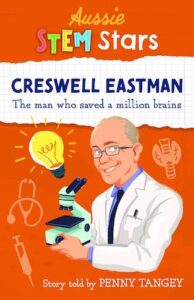 27 of 90 – Professor Creswell Eastman by Penny Tangey
27 of 90 – Professor Creswell Eastman by Penny Tangey
I love the Aussie STEM Stars series so much. Each book follows the real-life story of one of our wonderfully inspiring scientists, doctors or inventors, and is written by an award-winning kids book author. Professor Creswell Eastman is a world-renowned endocrinologist, who discovered that iodine deficiency in mothers can lead to profound physical and mental disabilities in their babies – over many years he quite literally saved the brains of millions of kids in China, Tibet and southeast Asian countries – and then realised it was becoming an issue in Australia too (although those salt-free foods and pink Himalayan salt that became so popular).
But this book, written with empathy, depth and humour by author Penny Tangey, is about more than just his achievements – it’s about his school days, his family and friends, the moment that turned him from the priesthood to a life of science (a blessing for so many!), what inspired his research and collaborations, and his intriguing travels around the world to help make a difference to so many people. A fascinating, fun and inspiring read.
* * *
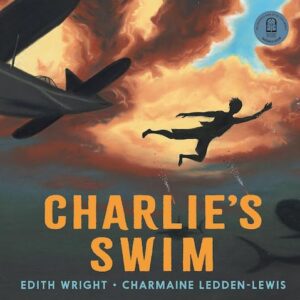 28 of 90 – Charlie’s Swim by Edith Wright
28 of 90 – Charlie’s Swim by Edith Wright
Aboriginal people have fought in every war Australia has been part of (although sadly many of the earlier ones were brutally waged *against* them by the colonisers – Australia has a dark history of horrifying massacres of our First Nations people), but until recently their bravery, and even their presence, has been largely unknown. One incredible story of courage is Bardi man Charles D’Antoine’s, which is told by his niece Edith in a heartfelt, simple way, and beautifully illustrated by Bundjalung artist Charmaine Ledden-Lewis. During World War II, Broome in WA was a military base for the Allies. On 3 March 1942, the town was attacked by Japanese fighter planes, which killed at least 88 civilians and Allied military personnel. Charlie was working inside a flying boat when the attack began. He managed to leap into the water before it was blown up and started swimming to shore – then noticed a woman and child desperately trying to keep afloat. Amongst bullets, fire and circling sharks, he swam back and rescued them, despite the danger.
It’s so wonderful that these stories of heroism are finally being told, as part of the truth-telling process this country so badly needs. My interview with Edith will be in the next issue of Australian Geographic Explorers, and Charmaine will be at the Sydney Writers Festival family day the day after the election… And for more brilliant kids books, check out Magabala Books.
* * *
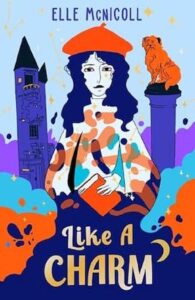 29 of 90 – Like A Charm by Elle McNicoll
29 of 90 – Like A Charm by Elle McNicoll
My favourite April read was Like A Charm by Elle McNicoll, a story of witches and sirens, family and friendship, secrets and betrayals, and discovering your own voice, strength and power. It’s set in an Edinburgh full of magical creatures, but twelve-year-old Ramya is the only person who can see through their human glamour to the truth – which is just as much of a shock to them as it is to her.
To fulfil her grandfather’s dying wish, she must learn about these Hidden Folk, get them to trust her, and find a way to help them. Which is no easy task. Like the author, the MC is neurodivergent. Ramya is dyspraxic, which affects motor skills and processing. It also affects the way people see her. Her parents, teachers and fellow students treat it like a curse, are dismissive and cruel, and have made her feel small, and incapable of achieving much at all. But as she meets witches, sprites, hulders and trolls, and is drawn deeper into their world, Ramya starts to realise that her differently wired brain is not a weakness but a strength. A superpower, and a gift to treasure.
Elle started writing because she was sick of seeing books where neurodivergent characters were totally absent or relegated to bit parts and burdens, lessons for the hero to learn from. “I want my characters to be aspirational, not educational. I want readers to rush to turn the page, not feel as if they are being lectured,” she said, and she absolutely succeeds. The book is emotional and sweet, and absolutely page-turning. As Edinburgh is wreathed in fog and enchantment, there’s danger, betrayal and plenty of mystery. Can she trust the siren or the vampire? What’s her mother’s secret? Why has her friend turned against her? And will she be able to figure it out in time to save them?
It’s a gripping, touching and magical read that made me long to return to Edinburgh. Plus, I’m a sucker for a Scottish accent, and the audiobook, narrated by Carmella Brown, brings the enchanted world and brilliant story so beautifully to life.
[ETA: Book two, Like A Curse, came out in August 2024, and is awesome too!]


Get Social